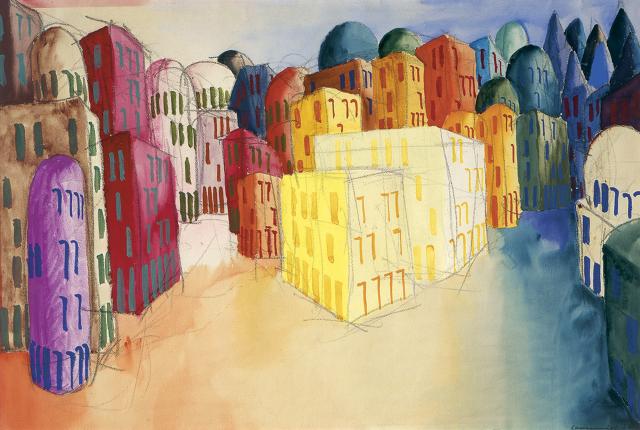An architect by training and profession, Paul Camenisch took up painting through the technique of watercolour. While the pencil, his initial work tool, still helped him to summarily construct the drawing of his compositions, it was replaced by neocolor (a colour pastel pencil) when it came time to define depth, volumes and values.
Representative of his earliest style, Platz I was part of the movement that produced metaphysical and utopian paintings depicting anonymous cities, a genre that developed in the 1920s in reaction to the growth of vast agglomerations and the modernisation of the living conditions in urban environments. His fantastic architectures with their vivid acid colours depict buildings with simplified volumes boasting thin vertical openings, standing side by side in a three-dimensional representation whose perspective is shifting, never unified. The unreal, expressive colour serves to differentiate the buildings, contrast their succeeding picture planes, and conjure up their materiality thanks to subtle gradations of diluted tones.
Dating from 1924, this drawing stands at a pivotal moment in the stylistic development of the artist, who had just discovered the work of Ernst Ludwig Kirchner and was executing his first paintings as part of the Rot-Blau group. Fleeing the alienation of urban life, the group’s members took artistic refuge in the isolated region of Mendrisiotto in the Ticino countryside, whose landscapes became the inexhaustible source of their new visual experimentations.
Representative of his earliest style, Platz I was part of the movement that produced metaphysical and utopian paintings depicting anonymous cities, a genre that developed in the 1920s in reaction to the growth of vast agglomerations and the modernisation of the living conditions in urban environments. His fantastic architectures with their vivid acid colours depict buildings with simplified volumes boasting thin vertical openings, standing side by side in a three-dimensional representation whose perspective is shifting, never unified. The unreal, expressive colour serves to differentiate the buildings, contrast their succeeding picture planes, and conjure up their materiality thanks to subtle gradations of diluted tones.
Dating from 1924, this drawing stands at a pivotal moment in the stylistic development of the artist, who had just discovered the work of Ernst Ludwig Kirchner and was executing his first paintings as part of the Rot-Blau group. Fleeing the alienation of urban life, the group’s members took artistic refuge in the isolated region of Mendrisiotto in the Ticino countryside, whose landscapes became the inexhaustible source of their new visual experimentations.
